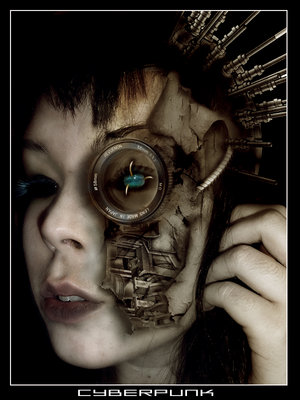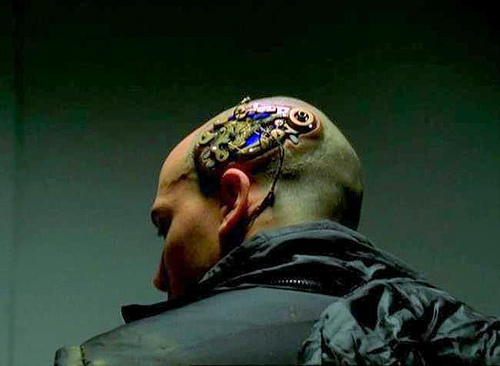The mind is a glorious thing to waste and I had five years to shred my gorgeous headmeat into mindflakes being an English major. English majors don’t exactly do anything worth their while and their diploma is a strong proof that they speak English more or less, which is, by the way, a strong prerequisite. (So I really, really had to start doing radio shows and copywriting instead of becoming a…. yes, anyways.) And there’s also a question of the thesis you have to write and everyone expects you either to write on Shakespearean tragedies, lesbian rapist literary theory (you wish) or postmodernism, this latter being something very trendy at the time. So me, wanting to be trendy and very unique all at once, stuck with cyberpunk, calling it postmodernist science fiction. And trust me, they were hooked. So much that my advisor thought that using a literary theory book on the homosexual white male body from the ancient Greek times to the 20th century could immensely fortify this thing I would write on, you know, hackers in hoodies, energy drinks and metal spikes that you jack into your slut body and you suddenly become an internet with eel porn and Cherenkov squirting videos.

So I actually decided to post this thesis in a few parts, firstly because I will seriously need to post some original stuff here and if it’s not, nothing is. (Half of it is stolen, by the way, as it is with all literature theses, you just don’t have the balls to admit that.) Secondly, the last part will contain two short parts that the advisor threw back as being pieces of journalism, not academic pieces of writing. I actually took them as compliments. Oh yes. When all that crap is posted, you’ll get the scribd link.
This thesis discusses how physical and virtual bodies are represented in the works of the founder of cyberpunk science fiction, William Gibson. The thesis examines how entities are manifested through technology in the physical and the virtual world, their motives, the effect of their gender on the world, including a brief introspective into the inner workings of the location commonly known as cyberspace. Throughout, comparisons are made between the IRL [in-real-life, physical] and the virtual. The tendency of the dissolution of the body and suchlike approaches is also discussed. It is suggested that beyond a fair amount of ambiguity, Gibson demystifies and reifies the body with its implants, the new cyborg entity and not the body as we knew it during the previous millennia. In the case of the Gibsonian dissoluted body, an entity is created in an experimental framework, re-forming conventional assumptions about desires, motives etc. This thesis was written in 2002 before Gibson published his long-awaited novel, Pattern Recognition, about a new way of sensory data perception and filtering.
0.0 INTRODUCTION
“My intention is to tell of bodies changed to different forms.”
(Ovid, Metamorphoses)
During the last half of the ‘80s, critics of cyberpunk identified its central narrative as the breakdown of boundaries between bodies and machines. Much of this critical writing was outright celebratory in its welcoming a new kind of science fiction which was obviously plugged in to present-state techno-reality. William Gibson even coined a term for the virtual space people started to spend time in – cyberspace, the other side of computer screens. Starting to make their first appearances in the mid-80s, cyberpunk’s technologized bodies seemed to provide images through which the readers could imagine their fates in the near future, especially if they were young white males with access to computer hardware.
 A lot of current critical thinking has fallen into the prison of the flesh. (The body as a central philosophical issue is particularly true among French philosophers, like Gabriel Marcel, Jean-Paul Sartre or Maurice Merleau-Ponty.) Even today there is a determination on the part of many critical thinkers to reinsert the meat into the picture, to resist the dreams of a disappearing body which have been influenced by technological fictions of its looming obsolescence.
A lot of current critical thinking has fallen into the prison of the flesh. (The body as a central philosophical issue is particularly true among French philosophers, like Gabriel Marcel, Jean-Paul Sartre or Maurice Merleau-Ponty.) Even today there is a determination on the part of many critical thinkers to reinsert the meat into the picture, to resist the dreams of a disappearing body which have been influenced by technological fictions of its looming obsolescence.
Although, if there is such an intense fascination with the fate of the body, is it not because the body does not exist any longer? Foucault is concerned with a continually disintegrating body, “traced by language, lacerated by ideology and invaded by the relational circuitry of the field of postmodern power” [Kroker, Theses on the… 20] Levin writes about of an Anti-System, “an alloy of classical substance and modern force” [Levin 101], which thinks of the body as an organless, closed and dimensionless surface. This concept of unextended matter and energy, a new body ideal is the manifestation of old and new referents of deconstruction.
The focus of this thesis is the body in interaction with the immersive digital / technological environment in the works of William Gibson. In doing so, I will employ a generous understanding of cyberspace, which is necessary in order to fully grasp the interrelations between physical and virtual space. Thus emphasizing the problematics of corporeality, I wish to signal my opinion that the bodies represented in William Gibson’s works show signs of potent de-construction and they are not facialized to the location we now commonly call cyberspace – becoming an ithis is contrary to the majority of cyberpunk literature of past years [Sterling, Stephenson, Egan, Fabi, among others], according to which the body is inherent in the virtual body’s sensory s[t]imulations.

This thesis is divided into four chapters. In the first chapter I briefly elaborate on a cyberpunk framework of concepts based on Ihab Hassan’s table of dichotomies. In the second chapter I start by establishing cyberspace as a location, as a place, both a social and a living space. Cyberspace is a location that certainly has a life of its own, with specific details, folds, peculiarities, representing a particular reality of feedback.
From the location of cyberspace I pass on to the phenomenon of the body inside and outside cyberspace and two of its avatars [the doll and the idoru] that are called forth by economic imperatives. I will scrutinize both body and mind, separately and in symbiotic terms. From that very definition of the body I will shift to the phenomenon of gendered technologies, to the impact of cyberculture, cosmetic surgery and virtual sex on the gendered body as the sexual aspect of the new body ideal or its new quality of presence.
I have ordered my thesis around the body’s relation with the perception/sensuality of space, the mind [as its superior driving force or its inferior ordering principle] and sexuality. I want to prove that William Gibson’s universe is an eclectic compound of post-modernist theories in which the body is coterminous with covert intertextuality and is a fragmented entity seeking to transcend itself.
1.0 CYBERPUNK: A FRAMEWORK
Beyond the eclectic and multi-accentual nature of cyberspace lies a strong hybridizing tendency, bringing together the scientific enthusiasm of the Industrial Age, the social enthusiasm of modernism and the sheer disillusionment of postmodernism. I tried to set up a new paradigm shift, a follower of Modernism and Post-Modernism under the name of cyberpunk, based on Ihab Hassan’s table of dichotomies [Bókay, 247-249].
This classification of CP as a paradigm is far from unmistakable. Cyberpunk is also a genre of literature and music, it is a fashion and art trend and also a youth subculture merging punks, hippies and computer campus geeks to represent a politically neutral, elitist and anarchist point of view. Cyberpunk as a paradigm is an effort to speak for all the before-mentioned aspects.
| MODERNISM | POSTMODERNISM | CYBERPUNK |
| Form (conjunctive and closed) | Anti-form (disjunctive, open) | Fragmentation/Hybrid |
| Hierarchy | Anarchy | Organized chaos, fractals |
| Proficience/logos | Exhaustion/silence | Resuscitation/White noise |
| Isolation | Participation | Spectator mode |
| Creation | Deconstruction | Gomi |
| Synthesis | Antithesis | Ephemeral dogmas |
| Presence | Absence | Shifting/Overlapping existence |
| Genre/Boundary | Text/Intertext | Hypertext |
| Semantics | Rhetorics | Memetics |
| Selection | Combination | Storage/Heaping |
| Interpretation | Misreading | Filtering |
| Signified | Signifier | Hyperlink |
| Lisible | Scriptible | Executable/Functional |
| Type | Mutant | Hybrid/Heterogeneous |
| Origin | Trace | Presence through traces |
| Transcendence | Immanence | Immanence/Imminence |
Hassan admits that he has not defined Modernism and he can define Post-Modernism even less. I suggest, though, that the complexity and unfinished nature of postmodern discourse has evolved into an open, evolving and at the same time, stable paradigm. Cyberpunk’s determinate and open-to-analysis characteristics is due to its integrity with technology.
It is observable that cyberpunk as a tendency is defined by a process of three steps, namely those of fragmentation / dissolution; a re-combination which forms a whole in which original components are still observable, and the re-introduction [“execution” as in running a program] of the new “hybrid” form into the environment from which it has been ripped away. The new hybrid will – due to its enhanced nature – establish connection with the old environment from the outside. It analyzes, organizes, stores and filters while not returning wholly to its previous state. It will act just as cyberpunk does in general – merge the most applicable functions that are most appropriate in any given state.
Flesh becomes integrated with machinery, in the process of something that is rightly called the dissolution of the body by Weinstein and Kroker and Kroker. Weinstein claims that the mind is being exteriorized (which I call the “spectator mode” in which the entity is capable of analyzing / filtering, seeing, immersing yet not being there in physical reality), Kroker and Kroker reveal that “we are being processed through a media scene consisting of our own (exteriorized) body organs in the form of second-order simulacra” [21] The body, according to them, is immersed in multiple subordinations to power apparati, ideologically, epistemologically, semiotically and technologically. In due order, these refer to the screenlike phase of the mutating body being inscribed by the fashion industry; a process of conditioning of the body for possibility for the operation of postmodern power; the body as a floating signifier of the imperatives of advanced capitalism and the subordination of the body to hyper-functionality.
Bodies as self-contained wireless information entities [cf. chapter 2.0], in terms of information theory are hypertexts, pieces of information connected by hyperlinks. Hypertext, as the concept for a non-sequential form of writing which could only exist in a computer environment, was coined by Ted Nelson in 1965. Nelson suffered from ADD (Attention Deficit Disorder) which caused him to forget a train of thought if interrupted, getting lost in a plethora of other associations. Ironically, hypertextuality / hyperlinking is a memory aid by which one can completely forget what they are looking for.
Bodies, entities of unity are not forgotten, though but are under the knife of the new paradigm, namely, the update. Cyberpunk age offers brochures advertising new implants and body parts instead of clothes. The inner [metabolical, psychologial, psychosomatical] harmony is facaded by a cascade of chaos, one of systematic randomness. Gibson’s characters exist in traces left in logs of computer transactions, notes of illegal clinics, memory fragments of ominous oracle-like figures (like the Finn or Ratz). What they are is built up of what they had done or seen. The life of Molly, for example, swarms with
galaxies of supposition, rumor, conflicting data. Streetgirl, prostitute, bodyguard, assassin, she mingles on the manifold planes with the shadows of heroes and villains whose names mean nothing to Angie, though their residual images have long since been woven through the global culture. [Mona Lisa Overdrive, 285].
The chapter “40: Pink Satin” of Mona Lisa Overdrive and chapter 23 of Neuromancer are one of the best examples of fragmented, and at the same time, completely organized way of perception.
Combination of the old and the new implies a resuscitation of obsolete materials and themes. However fragmented bodies of combination may be and whatever parts they might include, their union results in white noise , by this I mean a total masking of the self. Bodies are masked, dissoluted, hidden by their existence in fragments. The very same semblance is used in Mark Fabi’s Wyrm, describing the facilities of a military complex,
“Your guest cards […] adjust the settings for things like temperature, illumination level, even what kind of Muzak plays when you’re on the elevator. [..] You can customize your settings now – in fact, I’d strongly advise it – the Muzak default is Mantovani.”
“What if there’s more than one person on the elevator?” George asked.
“Then it compares the various lists of preferences and tries to come up with the best compromise. If it’s a total loss – say, Brahms, Anthrax, and Yanni – it’ll just pump in some white noise.” [187]
2.0 CYBERSPACE: THE PHENOMENA OF VISITATION
Cyberpunk’s eclecticity and multi-accentuality is paralleled by those of its related phenomena of Virtual Reality [VR], or also known as cyberspace. “Virtual Reality”, the phrase coined by the computer scientist and visual artist Jason Lanier in the late 1980s, is “computer-created sensory experience that allows a participant to believe and barely distinguish a “virtual” experience from a real one. VR uses computer graphics, sounds, and images to reproduce electronic versions of real-life situations.” [Franchi, online]
The body immersed in the virtual environment of cyberspace crosses over to the domain of the hybrid, for its humanity is irreversibly connected to non-human apparati. For example, Case, the console cowboy protagonist of Neuromancer who lived for the paradise of cyberspace, is “a byproduct of youth and proficiency, jacked into a custom cyberspace deck that projected his disembodied consciousness into the consensual hallucination that was the matrix” [Gibson, Neuromancer 12]. He experiences his exultation from cyberspace as the Fall as well as involving “a certain relaxed contempt for the flesh. […] Case fell into the prison of his own flesh.” [Gibson, Neuromancer 12]
The interpenetration of the organic and the inorganic elicits ambivalent responses, on one hand, technology is viewed as a magical potion which multiplies human powers ad infinitum, on the other, technology is associated with the engulfment of the human by the machine. Either way, the body constructed via technology displaces the binary opposition between wired and organic corporeality. [I will elaborate upon this matter in chapter 3.4, concerning the symbiosis of the body in mind in cybernetic symbionts.]
This binary opposition is resolved in the idea of Arthur Kroker and Michael A. Weinstein, transcending the concept of the wired nervous system buried in living flesh,
The hyper-texted body with its dedicated flesh […] wants to be an Internet. […] Operating by means of the aesthetic strategy of over identification with the feared and desired object, the hyper-texted body insists that ours is already the era of post-capitalism, and even post-technology. Taking the will to virtuality seriously, it demands its telematic rights to be a functioning interfaced body: to be a multimedia thinker, to patch BUS ports on its cyber-flesh as it […] goes wireless. [The Theory of the Virtual Class, online]
Gibson’s bodies are similarly not interfaced to the Net via modems and miscellanous software; they become their own self-contained nets, as in cruising cyberspace the players get physically involved with oceans of data that impact directly on their nervous systems and senses. Black ICEs are the most notorious picturesque example for this. These are mechanisms produced by artificial intelligences which can literally kill hackers initiating illicit incursions.

Gibson’s cyberpunk takes virtual technology further by posing the possibility of a NIL (neural interface link) between the human brain and the computer. This connection is effected by means of sockets situated behind the ear that can receive chips and thus grant access to digital memory. Once these gadgets function, human bodies and minds are not only in a position to enter an intimate relationship with computers, they also become able to access the ultimate virtual space and interact with other bodies and minds, they transcend the individual and the community to form a location which is built up of themselves.
2.1 THE PHENOMENA OF VISITORS
This narcisstic totalization of the self is best represented by the ominous Dixie Flatline of Neuromancer. It is “a ROM personality matrix… given sequential, real time memory” [99], de facto, the personality of a top hacker burnt into ones and zeroes, who [which?] acts as if he were “there”, on location with Case in c-space. Without an access to Case’s memory banks he [it] is just a [relatively] simple flood of logic and catchwords:
“’Hey, bro,’ said a directionless voice.
‘It’s Case, man. Remember?’
‘Miami, joeboy, quick study.’
‘What’s the last thing you remember before I spoke to you, Dix?’
‘Nothin’.’ […]
‘Okay, Dix. You are a ROM construct. Got me?’
‘If you say so,’ said the construct. ‘Who are you?’
‘Case.’
‘Miami,’ said the voice, ‘joeboy, quick study.’”
[99-100]
The motif of transcending into an entity of higher integrity (Dixie becoming a part of Case) is turned upside down in Count Zero and Mona Lisa Overdrive, where characters are ridden/possessed by voodoo gods/demi-gods.
In Count Zero cyberspace riders are thus not only situated along the symbolism of hi-tech societies but also along a religion that is close to that we know as Voodoo. Names and functions of loas connote a double referentiality, those of Voodoo and Christianity. This postmodern cyber-anthropology is stripped to the bone, formed by the connectivity of an artificial intelligence, the one that had been formed during the Straylight action minutely described in Neuromancer.
Cyberspatial existence in Count Zero is extended through suspension vats and sensory links and most importantly, biotechnology that takes over silicon. The motif of parallel worlds [existences] and their overlap climaxes in biochips, hybrid cancer cells transplanted into circuitries, cyberspace and manipulated human memory spontaneously intertwines. In Mona Lisa Overdrive the Finn becomes “a construct, a personality job, […] real-time memory if I wanna, wired into c-space if I wanna” [164] and Bobby Zero appears as a corpse wired into an Aleph, which is “completely interactive. And it’s a matter of scale. […] he literally could have anything at all in there. In a sense, he could have an approximation of everything…” [154]